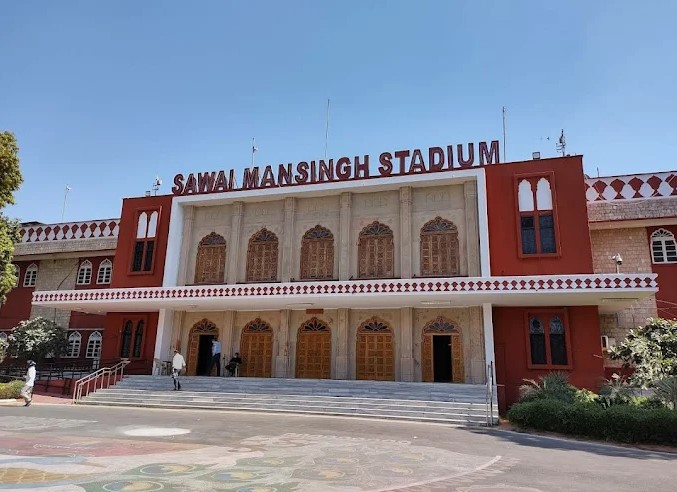Sawai Mansingh Stadium: Nestled in the historic city of Jaipur, the Sawai Mansingh Stadium (SMS Stadium) is one of India’s most iconic cricket venues. With a blend of modern infrastructure and deep-rooted heritage, the stadium is best known as the home ground of the Rajasthan Royals in the Indian Premier League (IPL).
Table of Contents
Sawai Mansingh Stadium: One of the key features influencing how cricket is played at this ground is its boundary length. In a game where inches can decide outcomes, the size of the playing field significantly affects strategies in batting, bowling, and field placement.
Stadium Overview
| Feature | Details |
|---|---|
| Location | Jaipur, Rajasthan, India |
| Year Established | 1969 |
| Seating Capacity | Approx. 30,000 |
| Ends | Pavilion End, City End |
| Home Team | Rajasthan Royals (IPL), Rajasthan |
| Surface Type | Grass with red soil base |
| Type of Ground | Oval-shaped |
Boundary Lengths at Sawai Mansingh Stadium
While not the largest stadium in terms of dimensions, the SMS Stadium presents a moderate boundary setup by international standards. The exact distances vary slightly depending on the pitch used (center or side strips), but average measurements are as follows:
| Direction | Average Distance (in meters) |
|---|---|
| Straight (long on / long off) | 70 – 72 m |
| Square boundaries | 66 – 70 m |
| Behind square (third man, fine leg) | 60 – 64 m |
| Deep cover / midwicket | 68 – 72 m |
These dimensions place the ground in a mid-range category, larger than venues like Sharjah or Eden Park but smaller than the Melbourne Cricket Ground (MCG) or Narendra Modi Stadium.
Pitch and Ground Configuration
Sawai Mansingh Stadium features multiple pitches on its square, and depending on which strip is in use, boundaries can become asymmetrical.
| Pitch Position | Short Side (m) | Long Side (m) |
|---|---|---|
| Center Strip | 70 | 70 |
| Offset Left | 64 | 76 |
| Offset Right | 63 | 74 |
This lateral shift of the pitch is often used tactically in T20 games to encourage or challenge scoring in certain areas. Captains use this variation to align their fielding strategies accordingly.
Impact on Game Formats
T20 Matches
In T20s, boundary length becomes a vital factor. The SMS Stadium has historically produced low-to-moderate scoring matches due to the nature of the pitch, which tends to be a bit slower and offers grip to spinners. While the boundaries are not tiny, they are not difficult to clear for set batters.
- Average 1st innings score in IPL: ~160–165 runs
- Six-hitting frequency: Moderate, with most sixes cleared square or straight
ODI Matches
In One Day Internationals, Jaipur has seen some high scores, but usually under conditions favoring batting second.
- Average 1st innings score: 260–280
- Chasing teams often do well due to dew and even boundaries
Test Matches
Though rarely used for Test cricket in recent years, the stadium’s pitch behavior favors spinners as the game progresses. Larger square boundaries come into play as batsmen struggle to rotate strike.
Comparison with Other Stadiums
To give context to SMS Stadium’s boundary dimensions, let’s compare it with other major cricket venues:
| Stadium | Straight Boundary | Square Boundary | Known For |
|---|---|---|---|
| Sawai Mansingh, Jaipur | 70–72 m | 66–70 m | Balanced, spin-friendly pitch |
| Wankhede, Mumbai | 65 m | 63 m | Short boundaries, high scores |
| MCG, Melbourne | 80–85 m | 85–90 m | Large ground, tough to clear |
| Chinnaswamy, Bangalore | 65 m | 60–65 m | Small ground, batting heaven |
| Narendra Modi, Ahmedabad | 75–80 m | 70–75 m | Modern and spacious |
Batting and Bowling Strategy
For Batsmen
- Target Straight: With straight boundaries in the low 70s, power hitters favor lofted drives and on-the-rise shots.
- Play to Square: The square region is slightly shorter than straight, making it a favorite for sweeps and cut shots.
- Running Between the Wickets: The large outfield means twos and threes are common, especially in ODIs and Tests.
For Bowlers
- Spinners: Excel here. The slower pitch and longer square boundaries give spinners room to toss the ball and entice errors.
- Pace Bowlers: Often use cutters, slower balls, and wide yorkers to restrict scoring toward the end of innings.
- Field Setting: Deep midwicket and long-off are crucial positions, especially with slightly larger off-side boundaries.
Notable Matches at Sawai Mansingh Stadium
| Match | Year | Highlight |
|---|---|---|
| India vs Australia (ODI) | 2013 | India chased 360 with ease, led by Rohit Sharma |
| RR vs KKR (IPL) | 2008 | First IPL Super Over finish |
| India vs England (ODI) | 2006 | Yuvraj Singh 86 (73) dazzled in a successful chase |
These matches illustrate how, despite modest boundary sizes, the SMS Stadium can produce dramatic results due to pitch conditions and team strategy.
Fielding Tactics Based on Boundaries
| Situation | Common Field Placements |
|---|---|
| Defending in T20 | Deep cover, long-off, deep midwicket |
| Death Overs Bowling | Third man, fine leg on boundary, square |
| Spinners in Middle Overs | Deep square, short third, slip |
| Powerplay Bowling | Inside ring pressure, one sweeper cover |
The Sawai Mansingh Stadium in Jaipur may not boast the largest boundaries, but its balanced dimensions offer a fair contest between bat and ball. The 70-meter straight hits, combined with marginally smaller square boundaries, allow skilled batsmen to find value for their shots without making the game one-sided.
Bowling teams, particularly those with strong spin options, thrive here — especially with smart field placements and use of slower deliveries. Overall, the boundary lengths at SMS Stadium shape every ball bowled, every shot played, and ultimately, the outcome of the game itself.


